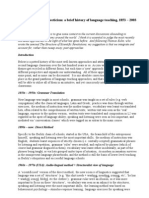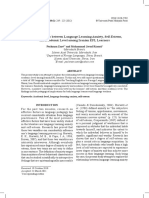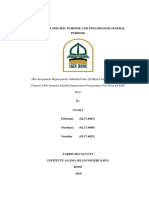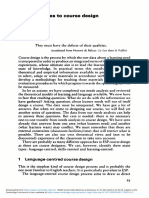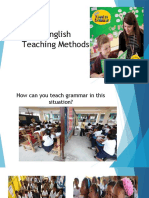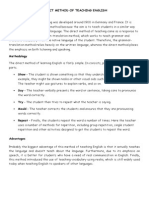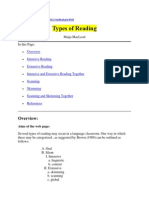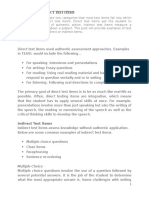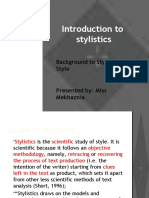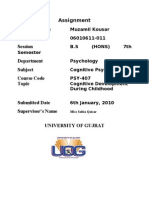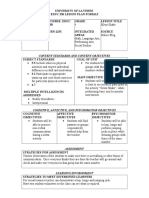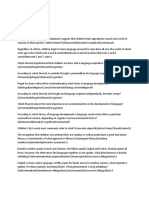Audiovisual Method: Theoretical Assumptions
Audiovisual Method: Theoretical Assumptions
Uploaded by
Valeska ManéCopyright:
Available Formats
Audiovisual Method: Theoretical Assumptions
Audiovisual Method: Theoretical Assumptions
Uploaded by
Valeska ManéOriginal Title
Copyright
Available Formats
Share this document
Did you find this document useful?
Is this content inappropriate?
Copyright:
Available Formats
Audiovisual Method: Theoretical Assumptions
Audiovisual Method: Theoretical Assumptions
Uploaded by
Valeska ManéCopyright:
Available Formats
Audiovisual Method
The audiovisual method is a method which refers to both sound and pictures which is typically in the form of slides or video and recorded speech or music; all is visual presentations that are shown by the teacher to the students. It can be called as a new trend because technology is used in this method such as, computers, televisions, language laboratories or the others which can support the teaching learning process in order to improve students skills. There are two categories: -Simple visual aids: It can be blackboard, bulletin board, funnel board, charts, diagrams, graphs, posters, maps, pictures, etc. -Advanced visual aids: It can be video, filmstrip, televisions, etc. It means the devices that can be used in this method are related to the ears and eyes. This method is most effective when the information is contained systematically organized. Break information into smaller chunks and grouping similar pieces together to help students connect and store information more efficiently. In this case, the teacher has to consider presenting the most important key points during the first part of the lesson, when their attention is at full capacity. This is related to a type of multiple intelligences which human has; it is visual intelligence which focuses on the ability of visualization.
Theoretical assumptions It includes: -The audio visual method seeks a basis in linguistics. -The visual presentation is intended to simulate the social context in which language used. -The assumed learning process of this method has an affinity with Gestalt psychology. It proceeds from total view of the situation to particular segments of language.
Characteristics of the Audiovisual Method There are some characteristics of this method: -The material is presented in visual form. -There is dependence on mimicry and memorization of set phrases. -Structures are sequenced by means of contrastive analysis taught one at a time. -Structural patterns are taught using repetitive drills. - There is little or no grammatical explanation. - Grammar is taught by inductive analogy rather than by deductive explanation. - Vocabulary is strictly limited and learned in context. - There is much use of tapes, language labs, and visual aids. - Great importance is attached to pronunciation. - Very little use of the mother tongue by teachers is permitted. - Successful responses are immediately reinforced. There is a great effort to get students to produce error-free utterances Therefore, this method is enjoyable. It is an interesting thing that students study through visualization.
Total Physical Response
TPR is one of the English teaching approaches and methods developed by Dr. James J Asher. TPR (total physical response) is a method of teaching language using physical movement to react to verbal input in order to reduce student inhibitions and lower their affective filter. It allows students to react to language without thinking too much, facilitates longterm retention, and reduces student anxiety and stress. In order to implement TPR effectively, it is necessary to plan regular sessions that progress in a logical order, and to keep several principles in mind. Characteristics of TPR: -Imperative drills are the prominent classroom activity in TPR. -Learners monitor and evaluate their own progress. -Learners feel free to speak outwhenever they are ready. -Listening and comprehension are emphasized over production inlanguage learning. -Vocabulary and Grammar are more emphasized than other language.
Procedure Steps in Total Physical Response: 1)The teacher says command y performs the action. 2) The teacher says command and both teacher and estudents perform the action. 3)Teacher says command Students perform the action. 4)Teacher tells one students to perform the action. 5)Reverse the roles or students give each other commands. Goals of Using TPR: -TPR was developed in order to reduce the stress people feel when studying foreign languages and thereby encourage students to persist in their study beyond a beginning level of proficiency. - This method attempts to focus mainly on encouraging learners to listen and respond to the spoken target language commands of their. The Roles of Teachers &Learners -Learners play main roles as a listener and a performer. The content of learning is little influenced by the learners. -Teacher is a director/commanderand model. -It is very effective with teenagers and young. Pros and Cons of TPR Pros: -It is a lot of fun andl earners enjoy it. -It is not required alot of preparation or materials using the TPR. -It works well with mixed-ability classes. Cons: -It does not give students the opportunity to express their own thoughts in a creative way. -It emphasizes to much on imperative mood. Students will be considered rude when attempting to use this new method.
Applied Linguistics
Audiovisual Method & TPR Method
VALESKA VEGA AGUIRRE VI SEMESTER
ENGLISH PEDAGOGY.
You might also like
- Inference Lesson PlanDocument3 pagesInference Lesson Planapi-263050636No ratings yet
- A Brief History of Language TeachingDocument7 pagesA Brief History of Language TeachingWilly100% (9)
- The Relationship Between Language Learning Anxiety, Self-Esteem, and Academic Level Among Iranian EFL LearnersDocument7 pagesThe Relationship Between Language Learning Anxiety, Self-Esteem, and Academic Level Among Iranian EFL LearnersDevi Nur AiniNo ratings yet
- Performance in Language LearningDocument6 pagesPerformance in Language LearningDedeh Kurniasih0% (1)
- Edtpa Lesson PlansDocument11 pagesEdtpa Lesson Plansapi-338231791No ratings yet
- Expanding Awareness and Contact Through Experiential LearningDocument24 pagesExpanding Awareness and Contact Through Experiential LearningASDSADASDSDSADNo ratings yet
- Background and Characteristics of The AudioDocument6 pagesBackground and Characteristics of The AudioRika NugrahaNo ratings yet
- EL 107 Working ModuleDocument95 pagesEL 107 Working Modulecharlesbagtas8No ratings yet
- Criteria For Selecting Literary Texts For A Language ClassroomDocument2 pagesCriteria For Selecting Literary Texts For A Language ClassroomLIAPKOP EMMANUELNo ratings yet
- Purpose of Using Literature in The Language ClassroomDocument9 pagesPurpose of Using Literature in The Language ClassroomSatria Baju HitamNo ratings yet
- Background of Audio-Lingual MethodDocument4 pagesBackground of Audio-Lingual Methodindra tamaraNo ratings yet
- Module 2 Materials EvaluationDocument9 pagesModule 2 Materials Evaluationkasugabarangay700No ratings yet
- STYLISTICS AutosavedDocument7 pagesSTYLISTICS AutosavedJoshua LagonoyNo ratings yet
- Exploring Literature Texts in The Efl ClassroomDocument14 pagesExploring Literature Texts in The Efl Classroomapi-262786958No ratings yet
- Celce Mucia Communicative Competence ModelDocument16 pagesCelce Mucia Communicative Competence Modelnjwoodward100% (2)
- The Scope of Syllabus DesignDocument4 pagesThe Scope of Syllabus Designkhedairianada2000100% (1)
- The History of English Language Teaching Methodology Short ArticleDocument4 pagesThe History of English Language Teaching Methodology Short ArticleYamith J. Fandiño100% (2)
- Sem119 - Teaching and Assessment of Literature StudiesDocument18 pagesSem119 - Teaching and Assessment of Literature StudiesJuly PontilloNo ratings yet
- Teaching Grammar Through TextsDocument2 pagesTeaching Grammar Through TextsESTERNINOSNo ratings yet
- English For Specific Purpose and English For General PurposeDocument9 pagesEnglish For Specific Purpose and English For General PurposeDiana NNo ratings yet
- Skill-Based SyllabiDocument9 pagesSkill-Based SyllabiNabilla PratiwiNo ratings yet
- DesuggestopediaDocument27 pagesDesuggestopediaLalila ZielaNo ratings yet
- Why Use of Literature in The ClassroomDocument23 pagesWhy Use of Literature in The ClassroomSachi pimentelNo ratings yet
- Approaches To Course Design PDFDocument14 pagesApproaches To Course Design PDFyamid rojas lopezNo ratings yet
- Checklist For Teaching Strategies Responsive To Learners' Special NeedsDocument3 pagesChecklist For Teaching Strategies Responsive To Learners' Special NeedsREBECCA STA ANA100% (1)
- Critical Period Hypothesis SummaryDocument2 pagesCritical Period Hypothesis SummaryFRANCISCO DURANNo ratings yet
- Systematicity and Variability in Interlanguage SystemsDocument30 pagesSystematicity and Variability in Interlanguage SystemsAbderrahim Agnaou67% (6)
- Types of Syllabi (1) 13Document36 pagesTypes of Syllabi (1) 13Veronica GuerraNo ratings yet
- A. Background: Arthur Hughes, Testing Language Teachers (New York: Cambridge University Press) 1989.P.101Document18 pagesA. Background: Arthur Hughes, Testing Language Teachers (New York: Cambridge University Press) 1989.P.101Hamka MobileNo ratings yet
- The Direct MethodDocument7 pagesThe Direct MethodKiochy Tucta ChavarriaNo ratings yet
- Natural Order HypothesisDocument4 pagesNatural Order Hypothesisjuansebas9800No ratings yet
- 8 Methods in Teaching GrammarDocument29 pages8 Methods in Teaching GrammarJenjen GammadNo ratings yet
- Direct Method of Teaching EnglishDocument5 pagesDirect Method of Teaching EnglishGenaroCárdenasNo ratings yet
- Wang (2010) Classification and SLA Studies of Passive VoiceDocument5 pagesWang (2010) Classification and SLA Studies of Passive VoiceEdward FungNo ratings yet
- Types of ReadingDocument19 pagesTypes of ReadingNursyazwani HamdanNo ratings yet
- Schema Theory and ESL Reading PedagogyDocument22 pagesSchema Theory and ESL Reading PedagogyAnDreez CamphozNo ratings yet
- Basic Features of CLTDocument9 pagesBasic Features of CLTMashella Mazinal100% (2)
- Lesson Plan 2Document7 pagesLesson Plan 2api-317480573No ratings yet
- Group 6 Applied LinguisticsDocument20 pagesGroup 6 Applied LinguisticsKylLe De Jesus DuroyNo ratings yet
- BackgroundDocument6 pagesBackgroundAldrin Louie Rivera100% (1)
- Discourse Theme and RhemeDocument3 pagesDiscourse Theme and Rhememajaculj0% (1)
- Observation Report On Child Language AcquisitionDocument11 pagesObservation Report On Child Language AcquisitionArisha KabirNo ratings yet
- Modern Schools of Linguistics The Mentalist SchoolDocument2 pagesModern Schools of Linguistics The Mentalist SchoolIdriss BenkacemNo ratings yet
- Teaching of ProseDocument10 pagesTeaching of ProseImran AiNo ratings yet
- MAT Audio VisualDocument11 pagesMAT Audio VisualGloria Lamasa Dela CruzNo ratings yet
- What Is The Difference Between Linguistics and Applied LinguisticsDocument3 pagesWhat Is The Difference Between Linguistics and Applied LinguisticsSeba OilherNo ratings yet
- Is Language Innate or LearnedDocument2 pagesIs Language Innate or LearnedAhmed altaloolNo ratings yet
- Module 5: Purposes and Functions of Language Assessment & TestDocument15 pagesModule 5: Purposes and Functions of Language Assessment & TestChasalle Joie GD100% (1)
- TTL - Lesson 2 (OBA 3 AND 4)Document5 pagesTTL - Lesson 2 (OBA 3 AND 4)TEPORA Johnhael JeoulsNo ratings yet
- Principles of Second Language Acquisition (SLA) Relevant To The Development of MaterialsDocument10 pagesPrinciples of Second Language Acquisition (SLA) Relevant To The Development of MaterialsKrystle Anne HensonNo ratings yet
- SAA - Resuello, Charles G - Task 1Document3 pagesSAA - Resuello, Charles G - Task 1Charles ResuelloNo ratings yet
- Direct and Indirect Test ItemsDocument3 pagesDirect and Indirect Test ItemsghluscuNo ratings yet
- 1 Stylistics (2) Master 2Document47 pages1 Stylistics (2) Master 2Safa Bzd100% (1)
- Assessing SpeakingDocument46 pagesAssessing SpeakingAngilly LibreaNo ratings yet
- Community Language LearningDocument19 pagesCommunity Language LearningfullhausNo ratings yet
- Language Testing:: Approaches and TechniquesDocument29 pagesLanguage Testing:: Approaches and TechniquesEldon Kyle JubaneNo ratings yet
- Universal GrammarDocument7 pagesUniversal Grammaranon-795907100% (2)
- Methods Approaches EflDocument29 pagesMethods Approaches Eflapi-317394066100% (1)
- Test Review - Methods and ApproachesDocument5 pagesTest Review - Methods and ApproachesManuella PantoNo ratings yet
- Grammar Traslation ApproachDocument4 pagesGrammar Traslation ApproachKarla María RaudaNo ratings yet
- EFL Methodology, Mistakes and Feedback: ITTT 003 © International TEFL Teacher Training 1Document25 pagesEFL Methodology, Mistakes and Feedback: ITTT 003 © International TEFL Teacher Training 1Minh TrầnNo ratings yet
- MethodsDocument8 pagesMethodsapro20178No ratings yet
- ALMDocument5 pagesALMFatin Nabihah RosliNo ratings yet
- Cognitive Psychology During Childhood (Muzamil)Document17 pagesCognitive Psychology During Childhood (Muzamil)MuzamilNo ratings yet
- Organisational Behaviour MBADocument47 pagesOrganisational Behaviour MBAsujanNo ratings yet
- Understanding The Self - Module 5Document5 pagesUnderstanding The Self - Module 5Glenndel RosauroNo ratings yet
- Intelligence: Triarchic Theory of Intelligence Robert Sternberg, 1949Document10 pagesIntelligence: Triarchic Theory of Intelligence Robert Sternberg, 1949MANVI JAINNo ratings yet
- Chapter 2 Brain and LanguageDocument30 pagesChapter 2 Brain and LanguageG. M.100% (3)
- Does Brainwave Entrainment Damage Your BrainDocument8 pagesDoes Brainwave Entrainment Damage Your Brainalina soareNo ratings yet
- Lesson Plan Rainy DayDocument2 pagesLesson Plan Rainy Dayapi-307989771No ratings yet
- Use of Case StudiesDocument11 pagesUse of Case StudiesAnanthi Rajayya RNo ratings yet
- The Positive Effects of Playing Video GamesDocument7 pagesThe Positive Effects of Playing Video GamesWill GutermuthNo ratings yet
- Eye Accessing Cues: Take A Moment To Consider The Following QuestionsDocument6 pagesEye Accessing Cues: Take A Moment To Consider The Following Questionsecartetescuisses100% (1)
- Dissociative Disorders - RamanDocument14 pagesDissociative Disorders - Ramanraman.pNo ratings yet
- Multiple Choice-WPS OfficeDocument11 pagesMultiple Choice-WPS OfficeShellamae Casol SegaNo ratings yet
- Lesson 3.1 The Aural Realm. Sound, Silence, Music, and NoiseDocument1 pageLesson 3.1 The Aural Realm. Sound, Silence, Music, and NoiseJustine Myein Oba TanalgoNo ratings yet
- Cognitive Impairment in Substance Abuse: Peter W. Vik, PHD, Tony Cellucci, PHD, Amy Jarchow, MS, Jill Hedt, BsDocument13 pagesCognitive Impairment in Substance Abuse: Peter W. Vik, PHD, Tony Cellucci, PHD, Amy Jarchow, MS, Jill Hedt, BsAdrian CanoNo ratings yet
- A. Summary of What Infants and Toddlers Can Do Cognitively: 0-6 Months 7-12 MonthsDocument40 pagesA. Summary of What Infants and Toddlers Can Do Cognitively: 0-6 Months 7-12 MonthsJohann Emmanuel MolatoNo ratings yet
- 02 Understanding Adult Learning ProcessDocument7 pages02 Understanding Adult Learning ProcessMak ShawonNo ratings yet
- Spacing and Lag Effects in Free Recall of Pure Lists: Michael J. KahanaDocument10 pagesSpacing and Lag Effects in Free Recall of Pure Lists: Michael J. KahanadaveparagNo ratings yet
- Organizational Behavior: Stephen P. RobbinsDocument17 pagesOrganizational Behavior: Stephen P. RobbinsDe LuicferrNo ratings yet
- Weebly - Presentation - TLCDocument6 pagesWeebly - Presentation - TLCapi-487262443No ratings yet
- Constructivism As A Theory For Teaching and Learning: What Are The Principles of Constructivism?Document14 pagesConstructivism As A Theory For Teaching and Learning: What Are The Principles of Constructivism?Patrizzia Ann Rose OcbinaNo ratings yet
- How To Answer and What To Say - Interview PreparationDocument3 pagesHow To Answer and What To Say - Interview PreparationvedantNo ratings yet
- MCQ On Module 1 - 21SFH19 - MMKDocument8 pagesMCQ On Module 1 - 21SFH19 - MMKSaha naNo ratings yet
- Intro To Philo of Man Lesson Plan Week OneDocument2 pagesIntro To Philo of Man Lesson Plan Week OneDejabGuinMajaNo ratings yet
- Final Project StoryboardDocument3 pagesFinal Project Storyboardcvavra2No ratings yet
- OriginalDocument2 pagesOriginalmaxalves77No ratings yet
- Manifest Your Desires - 2 Principles and 1 Process For Manifesting Your Desires PDFDocument5 pagesManifest Your Desires - 2 Principles and 1 Process For Manifesting Your Desires PDFShrikant DurwaasNo ratings yet

